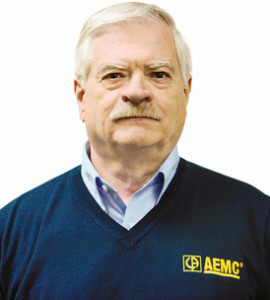
John Olobri
NETA Corporate Alliance Partners (CAPs) are a group of industry-leading companies that have joined forces with NETA to work together toward a common aim: improving quality, safety, and electrical system reliability.
In our continuing CAP Spotlight series, we highlight some of their individual successes. In this issue, NETA World interviews John Olobri, Director of Sales and Marketing for AEMC® Instruments in Foxborough, Massachusetts.
NW: What is something NETA World readers don’t know about AEMC?
Olobri: AEMC Instruments originally started in business in the United States in Boston, Massachusetts, in 1976 as Instrumentation Corporation. It was a distribution arm of Chauvin Arnoux based in Paris, France. As the business grew, a production facility opened in Dover, New Hampshire, in the early 1980s, and two additional business units were added. A name-change to Advanced Electrical Measurement and Control took place as it was a better fit for the company’s business model, and in the early 1990s, the name was shortened to AEMC® Instruments as it is known today. The company is incorporated as Chauvin Arnoux® Inc., d.b.a. AEMC® Instruments. It is still privately held and owned by the Arnoux family. AEMC was originally known as a premier supplier of current measurement probes, and we still hold that position. Today, we offer a wide range of test instruments for ground resistance testing, insulation resistance testing, power and energy monitoring, and much more. Chauvin Arnoux in France was one of the first developers of the multimeter.
NW: What recent company achievement or milestone are you particularly proud of?
Olobri: As a world-leading manufacturer of ground resistance test instrumentation, we continually look for ways to advance the technology to address the needs of the customer. Our latest offering to test the ground resistance of towers such as electrical transmission and cellular communication has greatly improved the safety of the technician doing the test, the quality of the test results, and the cost to get the job done. Our tower tester is capable of testing towers while they are energized or de-energized. In the case of electrical transmission towers, we can accomplish the testing without the need for a crew to climb the tower to disconnect the overhead ground conductor that runs from tower to tower in the transmission line. This alone saves considerable time and money for the utility company and is much safer for the personnel doing the work. The test results provided by this instrument include footing resistance of individual and total tower legs, quality of the overhead ground conductor bonding to the tower, leakage current, stray voltage, and a resistance vs frequency plot that provides valuable information of the reactive component — important to determine the effects of a lightning strike on the tower. All of this testing can be completed in 30 to 40 minutes where it would take several hours with other test methods. Today, several major electrical utility companies have standardized on our tower tester as the required instrument for their technicians and electrical contractors to use to verify that their transmission towers are within acceptable ground-resistance values.
NW: What evolution do you see on the horizon that will have a positive impact on your work?
Olobri: The cost and reliability of digital communication technology and the wide use of smart devices such as cell phones and tablets has given us the opportunity to effectively provide remote operation and access to test instrumentation. It allows the technician to remain outside hazardous areas while performing electrical measurements. It simplifies and reduces the time to properly configure the test instrument. It gives us the opportunity to provide real-time information, particularly in power and energy monitoring, to the appropriate decision makers and engineers anywhere in the world. Continued developments in this area will improve reliability of this communication and increase the transmission speed of large amounts of data. It will also help us simplify connectivity for the user who is interested in getting the job done right without spending an excessive amount of time learning computer technology to make that data communication happen. Springboarding off the developments of battery technology for the automotive industry and others will provide us an opportunity to offer longer operation of test and measuring instrumentation particularly in the area of data logging, which inherently is mostly used in unattended operation.
NW: What challenges do you see going forward for the industry?
Olobri: A most important challenge that faces the test instrumentation industry is in configuration simplification and presentation of application-oriented measurement results. Technicians and engineers today are pulled in many directions and are under considerable time pressures. The last thing they want to do is spend hours learning software or the layers of button-pushing to set up instrumentation. Although great strides have been made in this area, more needs to be done to literally make instruments as close to plug-and-play as possible and provide the operator the confidence that the instrument is configured right the first time and the results will be accurate.
